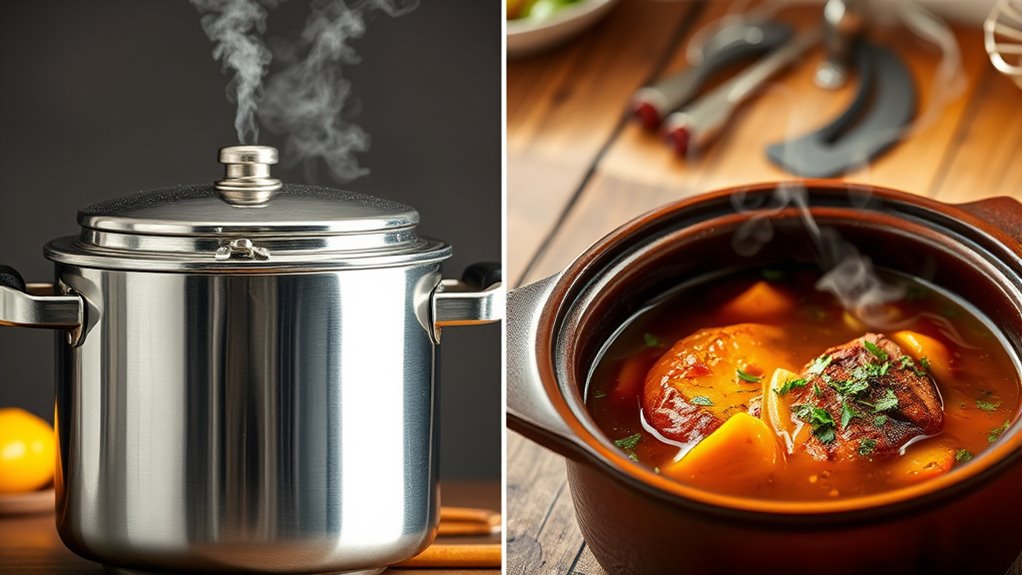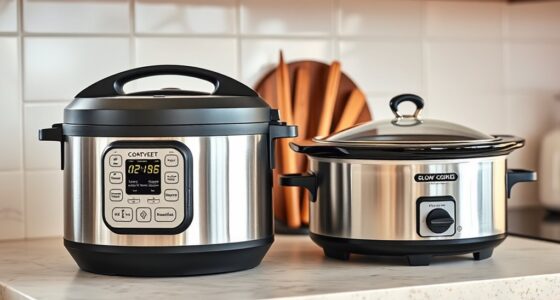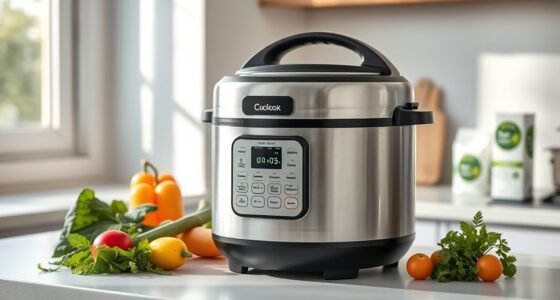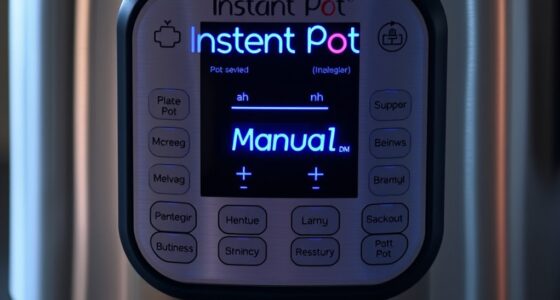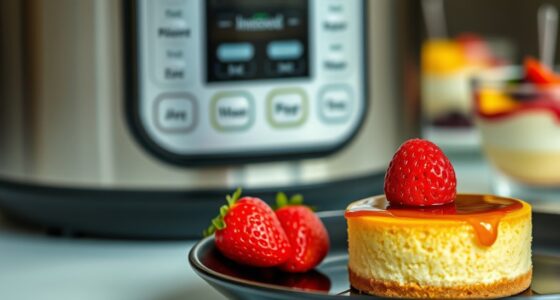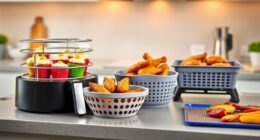Choosing between pressure cooking and slow cooking depends on your schedule and flavor goals. Pressure cooking saves time with quick, flavorful results, making it perfect for busy days. Slow cooking takes longer but allows flavors to develop fully, ideal for batch meals or tenderizing tougher ingredients. Consider what fits your lifestyle and taste preferences. If you continue exploring, you’ll discover how to maximize each method for delicious meals.
Key Takeaways
- Choose pressure cooking for quick meals and tender results, ideal when time is limited.
- Opt for slow cooking to develop deeper flavors and tenderize tougher ingredients over several hours.
- Use pressure cooking for rapid meal prep; select slow cooking for hands-free, long-duration recipes.
- Consider flavor development: pressure cooking infuses flavors quickly, while slow cooking melds them gradually.
- Match your schedule and desired texture to decide between the fast efficiency of pressure cooking and the slow, layered flavors of slow cooking.
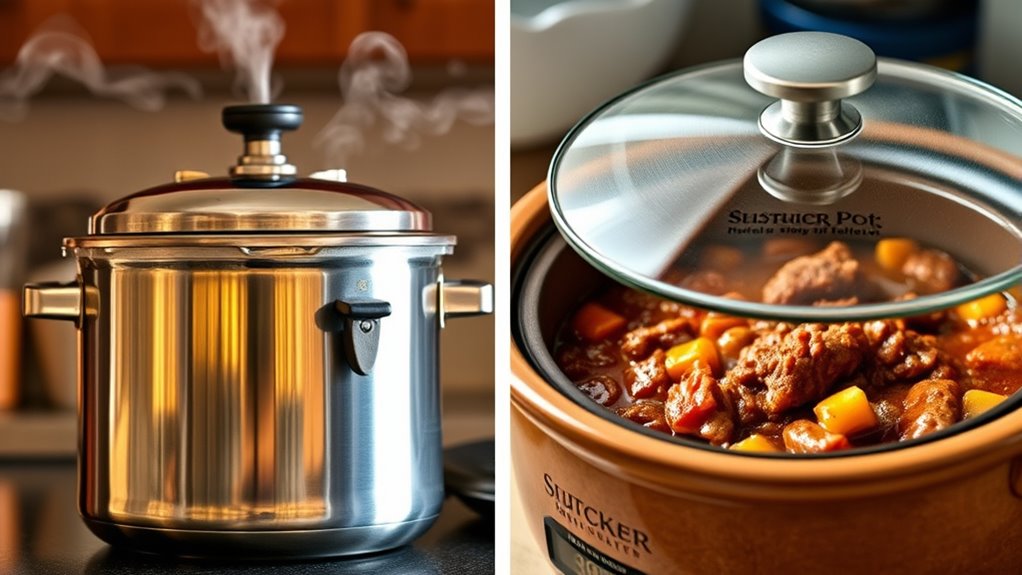
When deciding between pressure cooking and slow cooking, understanding how each method works can help you choose the best option for your meal. Both techniques offer unique benefits, especially when it comes to meal prep and flavor infusion. Pressure cooking uses high heat and steam under pressure to cook food quickly, typically in a fraction of the time compared to slow cooking. This makes it ideal when you need a fast, hands-off approach to preparing hearty stews, beans, or tender meats. On the other hand, slow cooking relies on low, steady heat over several hours, allowing flavors to develop gradually and deeply. If you’re planning meals ahead of time, slow cookers are perfect for meal prep because they let you assemble ingredients in the morning and come home to a ready, flavorful dish.
With pressure cooking, the rapid cooking process doesn’t just save time; it also locks in moisture and flavors quickly. When you close the lid and start the timer, the high-pressure environment causes the food’s natural flavors to infuse more intensely, resulting in dishes that have a rich, concentrated taste. This method is especially useful when you want to infuse flavors into tough cuts of meat or beans in a short period. Conversely, slow cooking allows flavors to meld over hours, creating a layered, complex profile. The extended cooking time enables ingredients like herbs, spices, and aromatics to permeate deeply into the dish, enhancing flavor infusion naturally. Additionally, slow cooking can be more energy-efficient for certain dishes over long periods.
Choosing between these methods depends on your meal prep needs and flavor goals. If you’re pressed for time but still want a well-flavored meal, pressure cooking is your best bet. It’s quick, efficient, and preserves nutrients better in many cases. However, if you prefer to prepare meals in advance, slow cooking offers convenience and a chance for flavors to develop fully over time. The longer cooking process also tends to tenderize tougher ingredients, making them melt-in-your-mouth delicious without much supervision. Both methods excel in flavor infusion but in different ways—pressure cooking achieves it through intense, rapid infusion, while slow cooking relies on slow, gradual blending. Ultimately, your choice depends on your schedule, the ingredients, and the depth of flavor you’re aiming for in your dishes. Understanding cooking techniques can help you optimize your meal preparation.
Frequently Asked Questions
Can I Convert Slow Cooker Recipes to Pressure Cooker Recipes?
You can definitely convert slow cooker recipes to pressure cooker recipes. For successful recipe adaptation, reduce cooking time considerably—usually by about two-thirds—and adjust ingredient quantities if needed. Keep in mind that some ingredient substitutions, like using less liquid or altering seasonings, help prevent overflows and ensure flavors develop properly. Always check your pressure cooker’s guidelines and start with simple recipes to master the conversion process.
How Does Cooking Time Compare Between Pressure and Slow Cooking?
They say “time is money,” and that’s true when comparing cooking methods. Pressure cooking dramatically cuts down cooking durations, often taking a fraction of the time slow cooking needs. If you value time efficiency, pressure cookers can prepare meals in about 30 minutes to an hour, whereas slow cookers may take several hours. Your choice depends on whether you prioritize speed or patience for flavors to develop fully.
Are There Foods That Are Better Suited for Pressure Cooking?
You’ll find that foods like tough cuts of meat and hearty vegetables are better suited for pressure cooking. This method quickly tenderizes meat, enhancing its tenderness, and maintains vegetable textures better than slow cooking. Pressure cooking is ideal when you want flavorful results fast, especially for dishes like stews or braises. It’s perfect for achieving juicy, tender meat and firm, well-cooked vegetables without losing their natural textures.
What Safety Precautions Are Necessary for Pressure Cookers?
When using a pressure cooker, you need to prioritize safety. Always check that the pressure valve is clean and functioning correctly before cooking. Guarantee the safety lock is engaged properly to prevent accidental opening during pressure buildup. Never overfill the cooker, and follow the manufacturer’s instructions carefully. Regularly inspect the seal and valves for wear, and release pressure safely after cooking. These precautions keep you safe while enjoying the benefits of pressure cooking.
Do Flavor Profiles Differ Significantly Between the Two Methods?
Think of your dishes as a symphony; flavor nuances and ingredient interactions dance differently depending on the method. With pressure cooking, flavors meld quickly, creating intense, concentrated tastes like a fireworks show. Slow cooking, however, allows ingredients to mingle gradually, revealing subtle layers like a gentle sunrise. So yes, flavor profiles differ markedly—pressure cooking delivers bold, immediate notes, while slow cooking offers a more nuanced, harmonious flavor journey.
Conclusion
So, whether you prefer the quick thrill of pressure cooking or the leisurely pace of slow cooking, remember that both methods have their perks—and quirks. Ironically, the faster option often requires more attention, while the slower one lets you forget about dinner entirely. Ultimately, it’s all about your schedule and patience. Either way, you’ll end up with a delicious meal—just don’t expect to master both techniques without a little trial and error.
